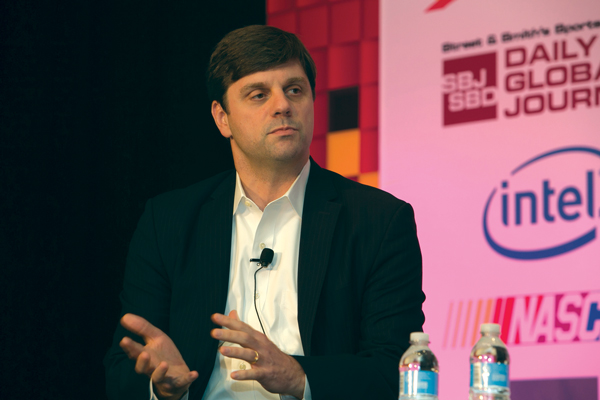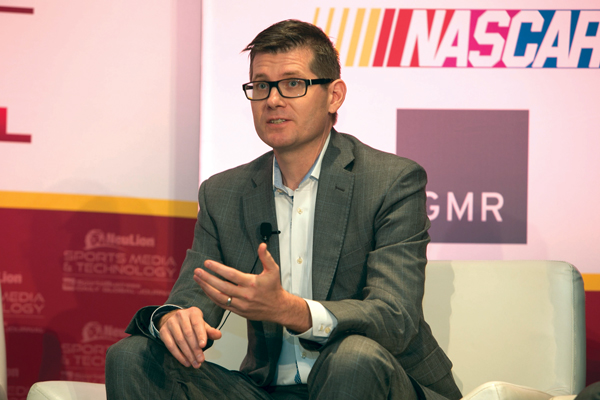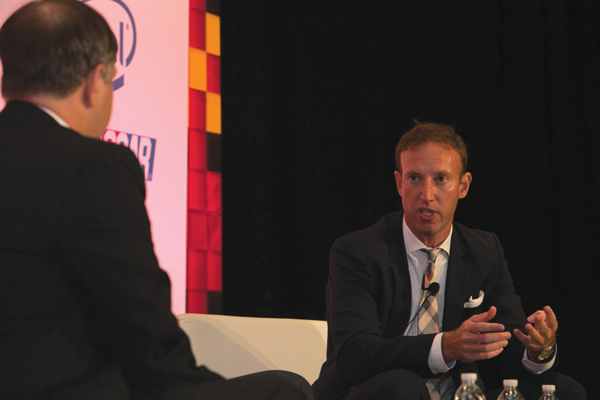Los Angeles Clippers owner Steve Ballmer says his media rights deal with Fox Sports Prime Ticket will spur a “transformation in the way sports gets consumed.”
On the same stage just two hours later, Fox Sports President Eric Shanks called it just another television rights deal. “It’s not unlike other deals that we’ve done on the local side,” Shanks said.
Ballmer and Shanks don’t disagree exactly. But their views highlight the wide range of perspectives on when that transformation will occur. Like everyone else in the sports media business, they acknowledge the changes coming to the way fans watch sports. But over the course of two days at the NeuLion Sports Media & Technology conference, speakers offered a wide range of viewpoints about how fast those changes are coming and what role traditional television plays in that future.
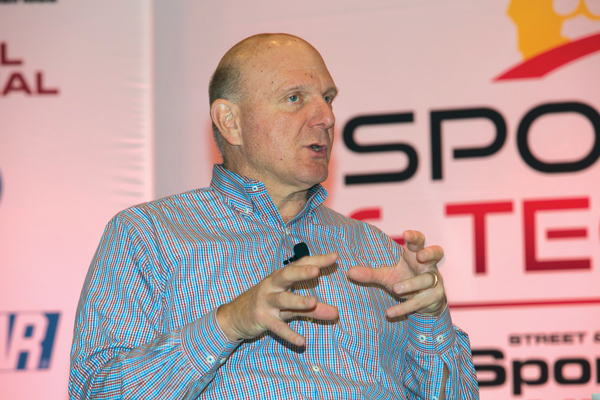 |
Steve Ballmer
Photos by: TONY FLOREZ PHOTOGRAPHY
|
Ballmer has one view — he believes the future is now.
Ballmer, who said he was prepared to stream his team’s games for free if he didn’t reach a local Fox deal, said traditional television companies and distributors need to start embracing digital more than they currently do. He compared the digital viewing revolution to the retail music market in the 1990s, when brick-and-mortar CD stores gave way to MP3 sales, and the old-line retailers lost out to newcomers like Apple.
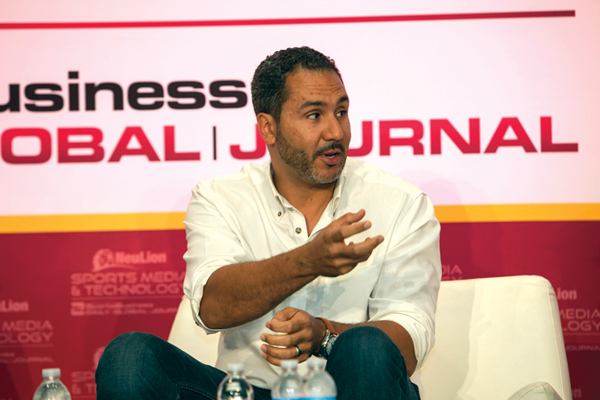 |
Facebook’s Dan Reed
|
“It was like fighting a tidal wave, it was going to happen,” he said.
Shanks has a slightly different view. The future still is years away.
“We’re going to work with Steve and his vision around creating a new experience for super Clipper fans,” Shanks said. “We’re going to collaborate with some technology that he’s invested in and tested over the next couple of years and see where the landscape goes from
 |
ESPN’s Stan Verrett
|
there.”
Ballmer complained that innovation is being held back by the complex web of broadcast rights deals, which keeps any one player from moving aggressively and comprehensively, pointing out that the league holds some media rights and the teams own others.
The Clippers held back some digital rights from the Fox deal and are building a direct-to-consumer product designed to make the at-home experience like watching from the stands. He described a vision of augmented reality giving fans the chance to watch the game from the vantage point of Chris Paul, via mobile devices, within three years.
Still, several of the biggest names in sports media gave full-throated defenses of television. Take the NFL, for example. The league is enamored with its Snapchat and Twitter partnerships, which are adding new viewers and revenue. But television will remain indispensable to the NFL’s media strategy of maximum reach for the foreseeable future, according to the league’s executive vice president of media, Brian Rolapp.
“There’s been nothing on the internet that can support 15 to 20 million concurrent views at the quality that you get on television,” Rolapp said. “Seeing the internet get to that point is important for us, and important for anyone who’s in the business of mass delivery of content.”
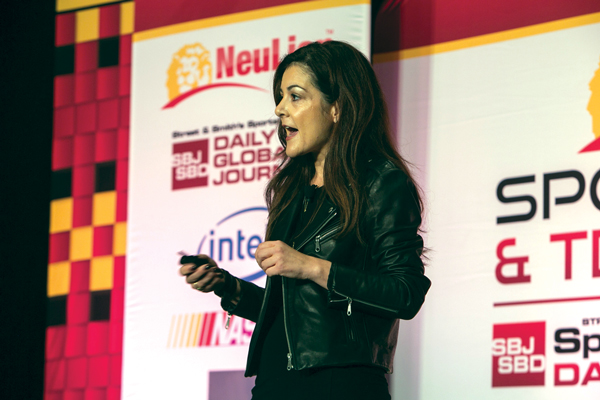 |
Intel’s Sandra Lopez
|
Four weeks into the NFL’s deal to simulcast “Thursday Night Football” on Twitter, Rolapp said, the evidence shows viewers still want the large-screen television experience.
“People migrate to the largest screen possible,” Rolapp said. “When people were watching the Twitter games, most of it was mobile. It was people who were displaced from a larger screen, or wanted the social experience.”
Other top executives, like Universal Filmed Entertainment Group Chairman Jeff Shell and Activision Blizzard Chairman Steve Bornstein, agreed. They both laughed off suggestions that traditional television is on a significant downswing. They said television will remain the most powerful media platform, especially for sports, for a long time to come.
“Prime time [viewing for the Olympics] went down, but it was still the lion’s share of the viewership,” Shell said.
Both, however, acknowledged the growth of digital media. They predicted that the traditional TV players will be big digital players and will adapt to the new environment, just as broadcasters eventually did after the cable industry became more popular.
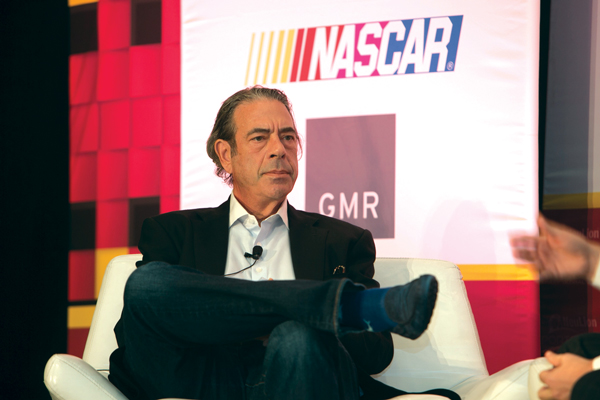 |
Steve Bornstein of Activision Blizzard: “It’s not so much a challenge as a transition.”
Photo by: TONY FLOREZ PHOTOGRAPHY
|
“Is the world changing? Certainly. Are some latency businesses having to deal in a linear world with a digital future? Yes,” Bornstein said. “It’s not so much a challenge as a transition.”
For his part, Ballmer first began thinking about the structural impediments to digital innovation as CEO of Microsoft, when he wanted to use the Xbox to introduce a new NFL viewing experience. It proved impossible with four rights-holding networks.
“There will need to be a coherent vision for innovation, and we know that’s not going to come from any one party here,” he said. “It’s going to come from tech providers — we’ve picked NeuLion and Second Spectrum for basketball to go innovate — but then there’s still a question of who’s going to package it all together.
“I didn’t want to wait to get started until the cable guy decided with the network guy, and decided with the league guy, who’s already got all their rights licensed for 10 years.”

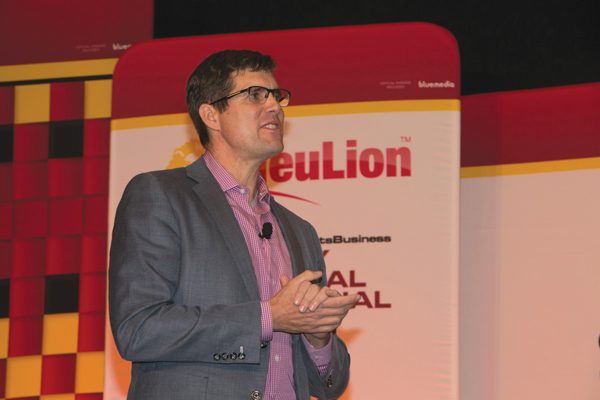 |
Photos by: TONY FLOREZ PHOTOGRAPHY
|
“We don’t market to customers anymore. Customers market to themselves. We give them information. It makes sports, entertainment and other passion points incredibly important.”
ANDREW SHERRARD
CHIEF MARKETING OFFICER, T-MOBILE
“We think of [NFL Network] less as a TV network and more as a content factory that’s feeding three parts of our media model.”
BRIAN ROLAPP
EXECUTIVE VICE PRESIDENT OF MEDIA, NFL
“Much like I grew up in Wisconsin and will always be a Packers fan, our viewers are tied to their cultural touch point in Mexican league soccer.”
ERIC RATCHMAN
EXECUTIVE VICE PRESIDENT OF CONTENT DISTRIBUTION, UNIVISION
“October could be the best month in the history of FS1. I take issue with the idea of decline at FS1. We’re in growth mode.”
JAMIE HOROWITZ
PRESIDENT, FOX SPORTS NATIONAL NETWORKS









